Tillandsia ramellae
Click thumbnails for full size, scaled to a new window.
Tillandsia ramellae
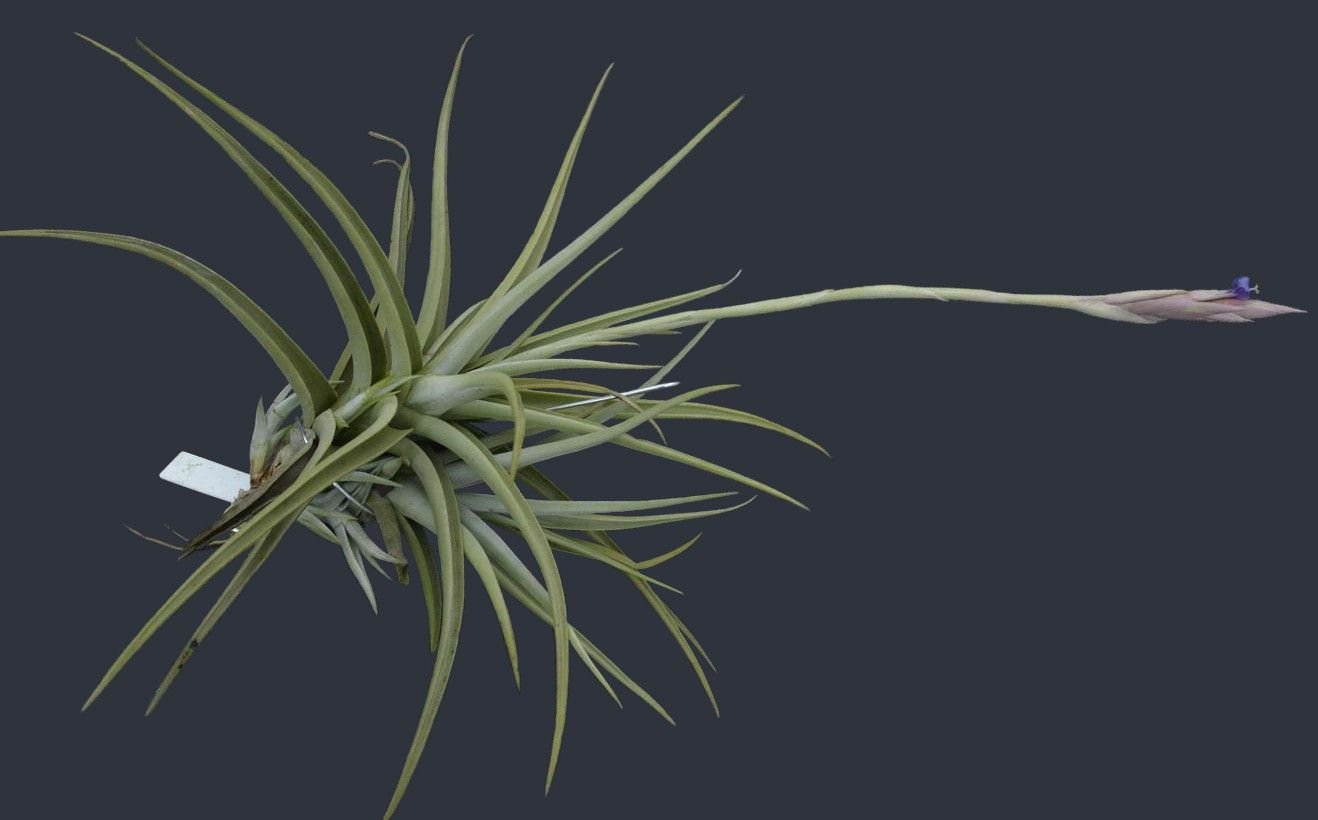
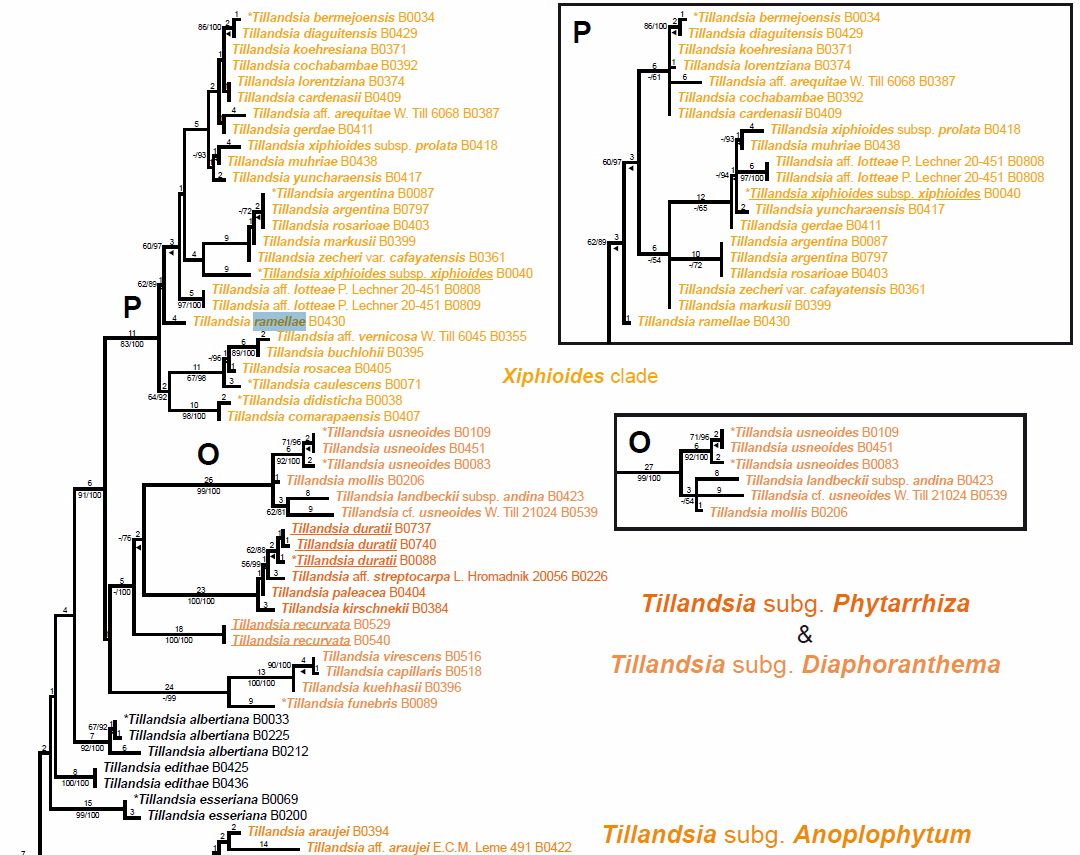
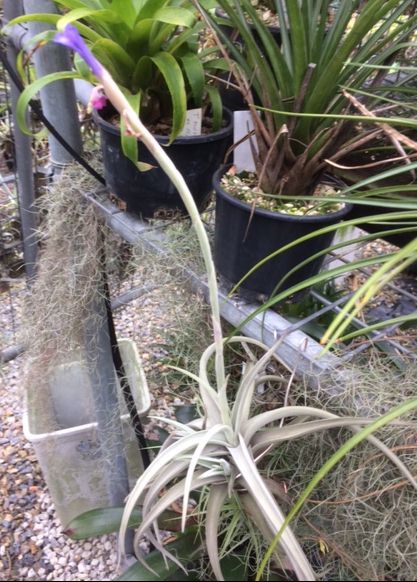
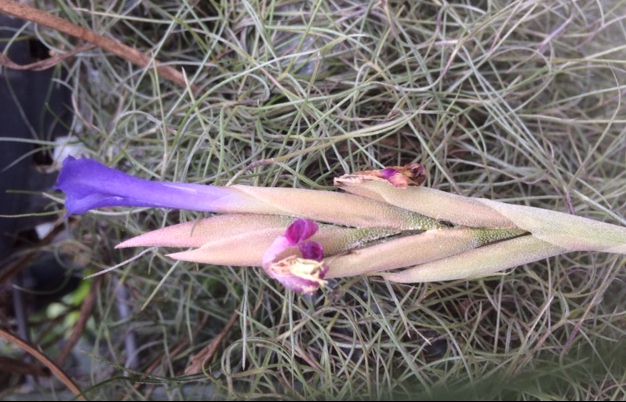
| Peter Tristram 06/17 |
John Olsen 02/18 |
Peter Tristram ... "This one is for Bruce Dunstan before he disappears over the horizon into the soggy Heaven of NW Ecuador. I am waiting for fresh flowers to do a better photo shoot. Interesting species!"
Len Colgan ... "This rare(?) T. ramellae species comes from the Chaco desert-like region in the north-west of Paraguay near the Bolivian border. How long have you had it before it flowered? I have a couple of large clumps from many years ago, but none have yet flowered.
Even though the differential diagnosis was with T. esseriana (also from Paraguay), it does seem closer to the T. lorentziana group. What is your opinion?"
Peter Tristram ... "I first got it as xiphioides var lutea from Renate but soon realised the mistake! Bruce got a piece (as xiph lut – I am not a hoarder!), fattened it up and released a few plump ones last year at the Brisbane Till Day. I decided to buy back a fine specimen and it is the one in bloom. I have another coming into bloom too. I also acquired the species from Holm, Heidelberg, Lotte, Walter (got to be the real deal!) and other sources, not always as ramellae either, hence so many sources, but the ‘look’ of the plant gives it away. Whether they are all the same clone I do not know.
I checked on its placing in the 2012 Barfuss dna chart and it fits in on its own branch evolving separately but at roughly the same time as lotteae, etc (see chart). T. lorentziana is in there too but perhaps a little more distant. I’d love to see photos of the habitat and might ask Walter if he has any. I’ve parted with quite a few over the years and wonder if anyone else has bloomed it. Timm Stolten asked me to send photos if I ever bloomed one so it must be a rare occurrence. Nutters might find the info in Derek's dvd very interesting too."
Len Colgan ... "Very interesting Peter!"
When I visited Walter Till in the mid-1990s about the time the species was described, he was reluctant to reveal the precise location to me, probably concerned about over-collecting. However, I see that he did provide quite accurate coordinates in the description of T. ramellae, which comes from a restricted habitat.
I gather from your comments that it is more spread in Australia than I imagined, certainly more so than in the USA.
Do you know about Walter's co-author in the description of this species? Susanne is Walter Till's wife. I believe there are only one or two tillandsias that they jointly described. I have always wondered if they might have been together in Paraguay at the time."
Pam Butler ... "I purchased my plant from Peter in 2009 and I am still waiting for it to bloom."
Peter Tristram ... "I think Susanne is Walter’s wife. He has mentioned a lady and a couple of very large dogs to me.
I hope the habitat remains largely intact. Unfortunately commercial collectors have decimated localised accessible populations of desirable Tillandsia species in various counties. I hope those days are past and populations can recover. Because T. ramellae is such a stunning species and pups well it will become more known and likely even more in demand."
Bruce Dunstan ... "Attached is Pitcairnia susannae named for Susanne. We saw it in Western Colombia in Pluvial forests. It was described in Ecuador so we may see it in the coming weeks." (Ed. See Pitcairnia entry.)
Len Colgan 02/18 ... "Well done John, I have had plants of this Paraguayan desert species for a long time, but not one has ever flowered."
Bruce Dunstan 02/18 ... "Same for me Len. I have taken pieces off my clump and they flower for others but I’m still yet to flower it."
Peter Tristram 02/18 ... "I bloomed 2 plants last year, ex Bruce, ex me lol but apparently with altered chemistry! One of Bruce’s chemically enhanced plants had a branched spike. I’m sure I posted pics which I also sent to some of my European colleagues who’d always asked to see a blooming specimen. Walter disputed its identity until I let him know the specimen was well fertilised. He was happy with the single spiked plant though, both from the same mum. I tried to pollinate and cross it without success. So, Len, you might have to feed yours!"
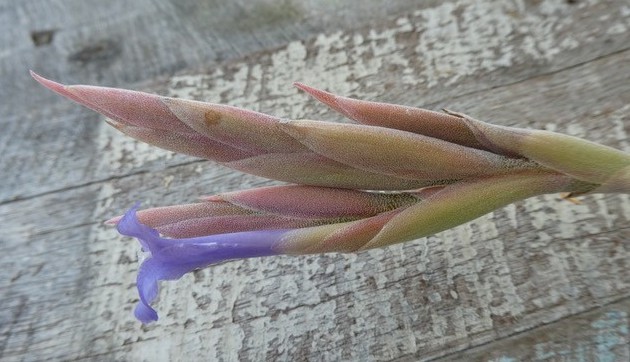
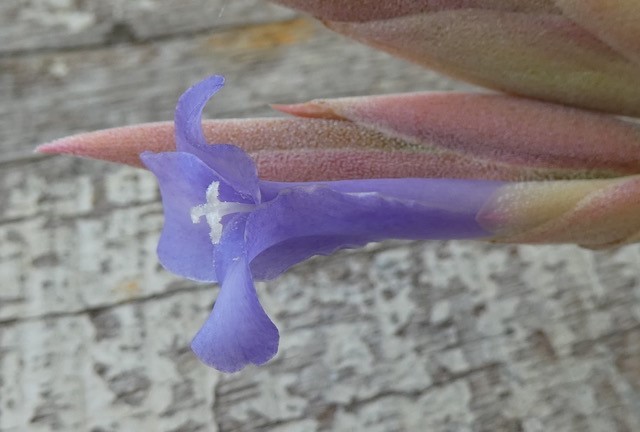
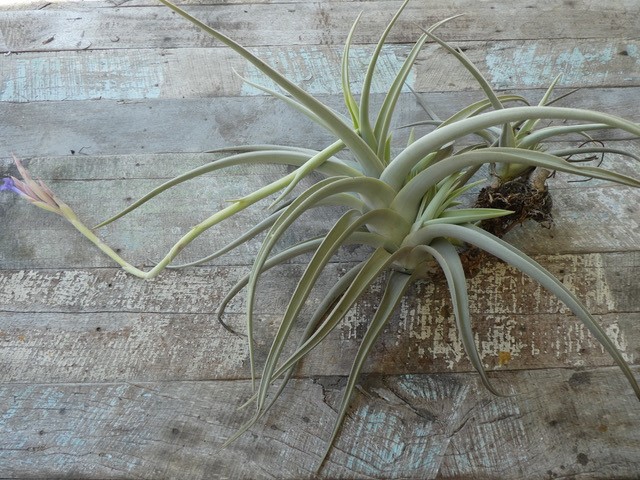
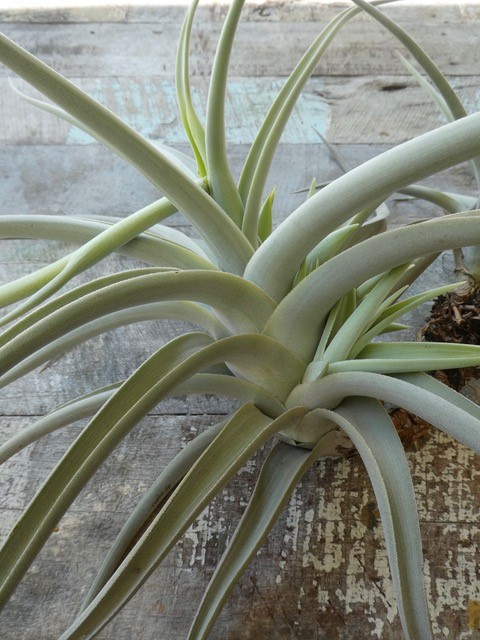
Bruce Dunstan ... "Finally my plant has flowered. A bit of bird damage on the spike had me concerned. I got this plant from Peter Tristram at a Tillandsia Day at John Olsens old house and unfortunately I didn’t record how long ago it was. No doubt my nutrition regime has resulted in the multi branched spike."
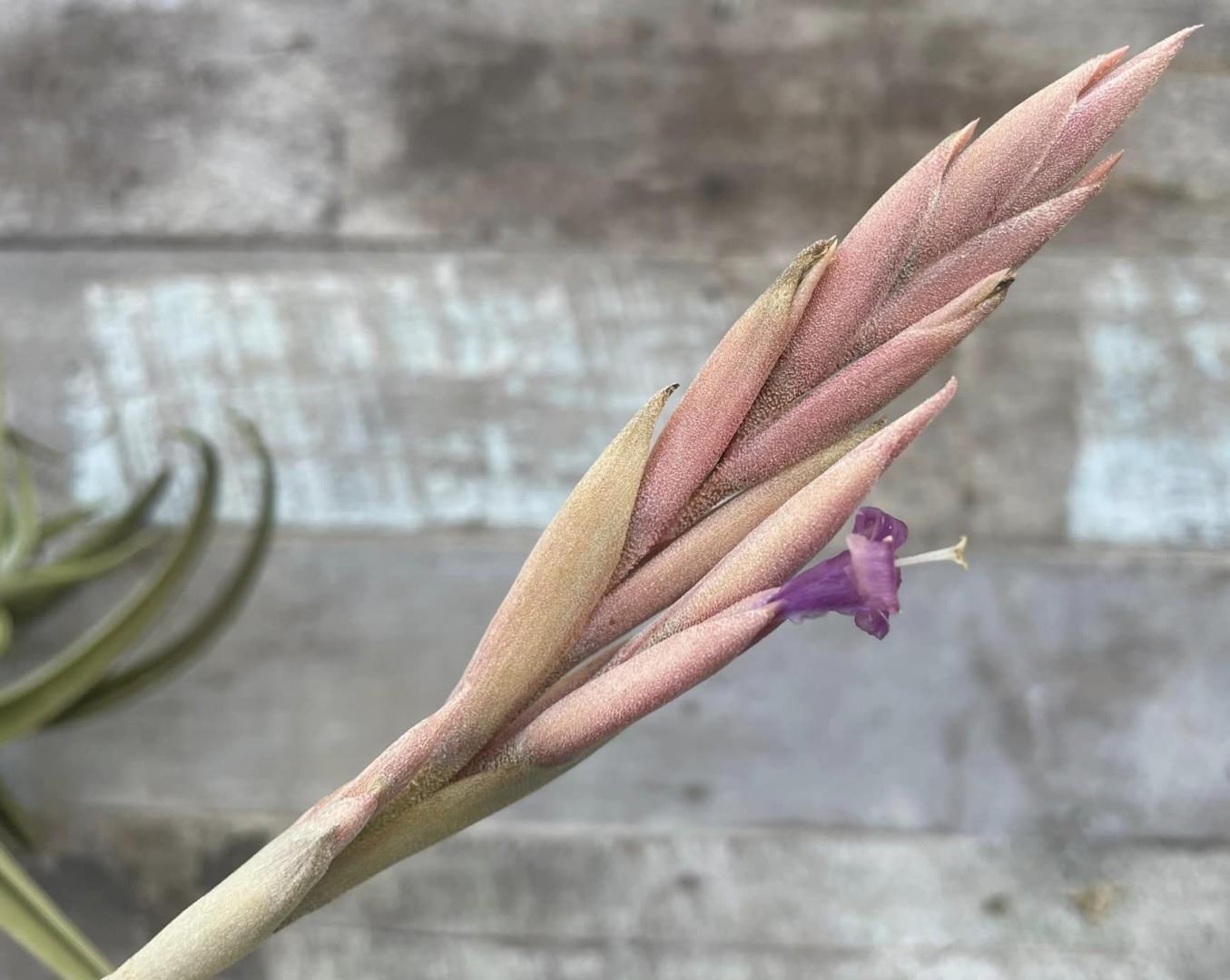
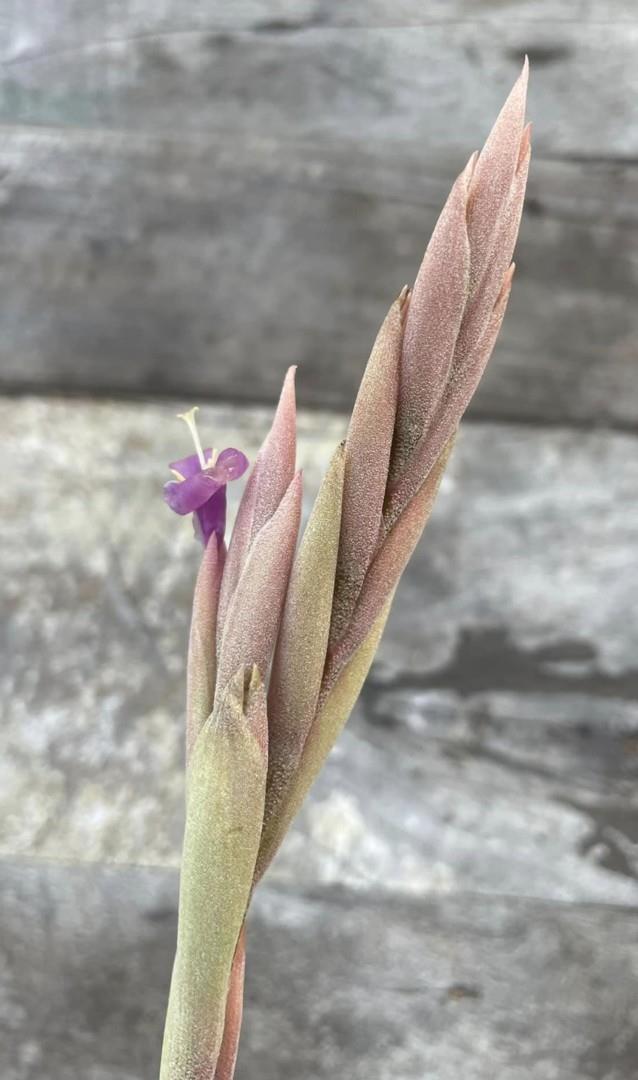
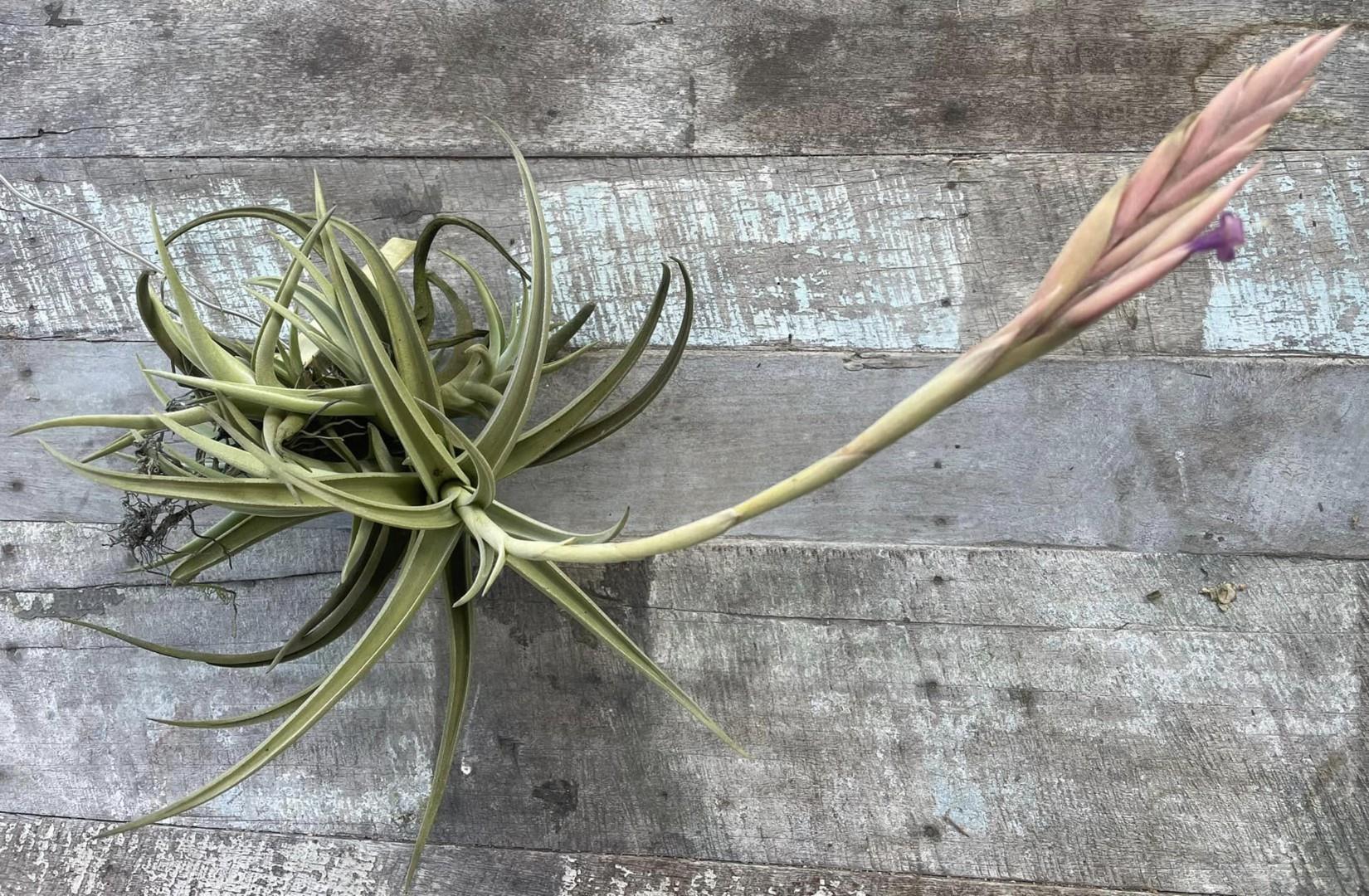
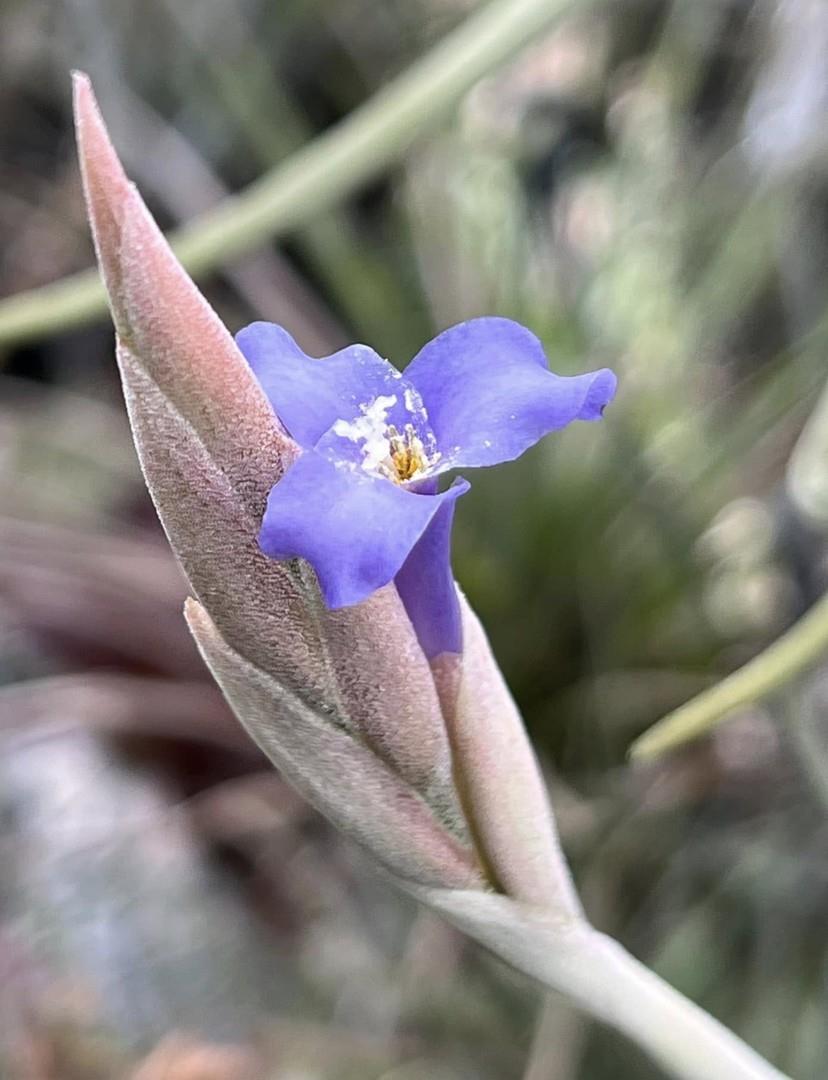
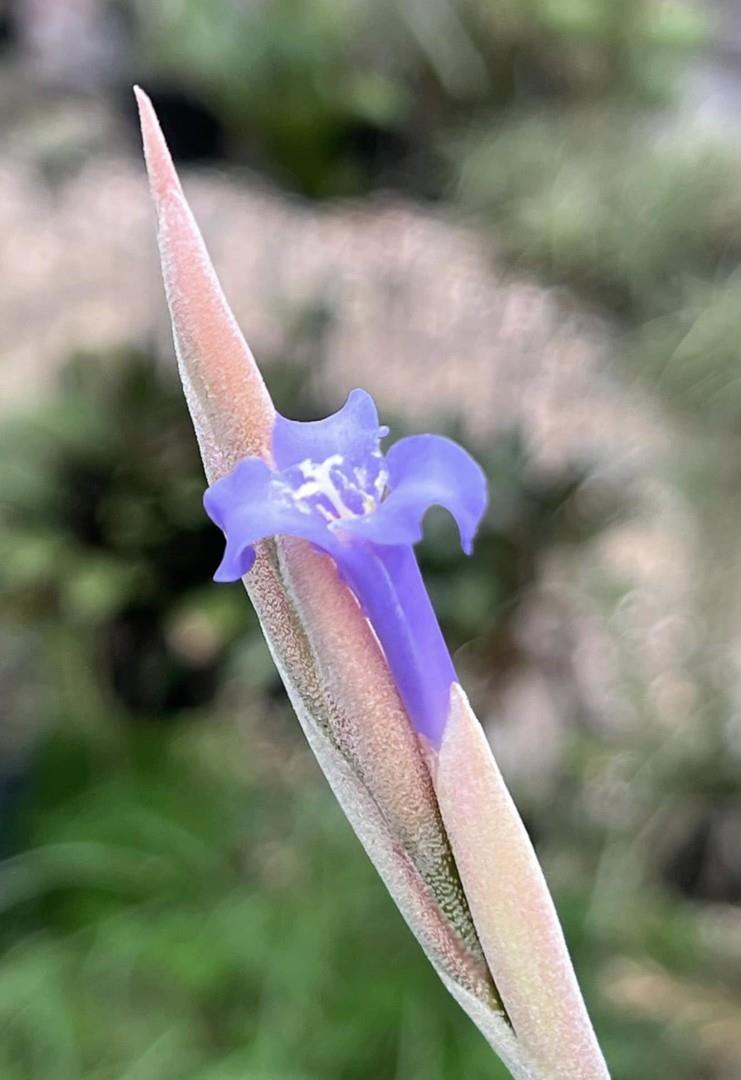
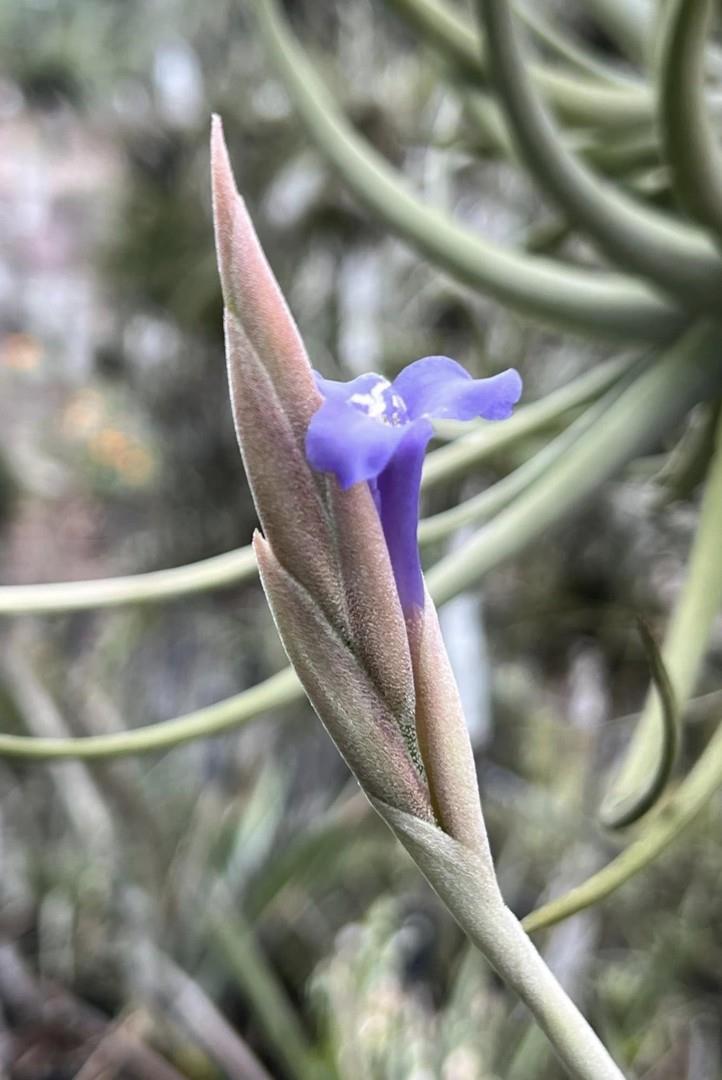
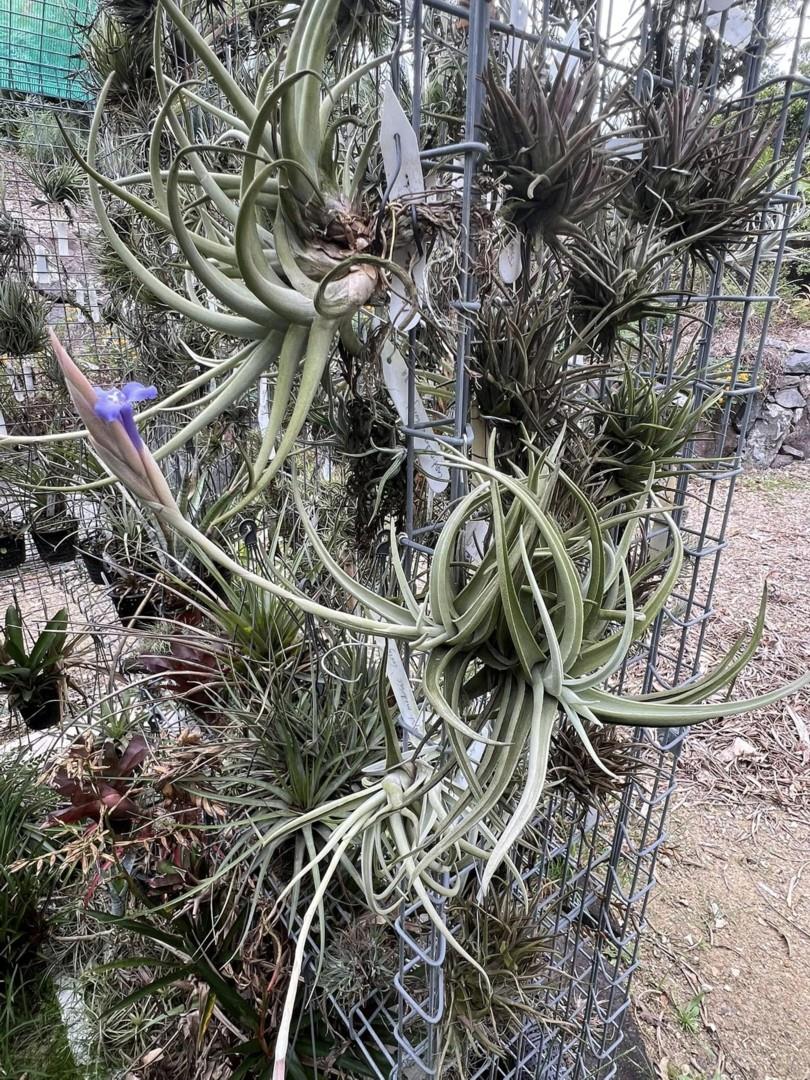
Tillandsia ramellae W. Till & S. Till, Candollea 50 1995 p455-6
A Tillandsia esseriana Rauh & L. B. Smith caule distincto, (5-)10-30 cm longo, indumento foliorum subtomentoso non adpresso, foliis margine laminarum supra vaginas ciliato-lepidotis. scapo inflorescentiae longiore et bracteis florigeris sepalisque perlepidotis non glabrescentibus differt.
Holotypus: PARAGUAY. Chaco; "Cerro Cnel. f. Cabrera, 640 – 680 m.s.m." 19deg 39' S. 61deg 44' W., 25. IV. 1989, Ramella, l., LR 2879 (G!), Isotypi (CTES! FCQ!, G!, MO!, WU!)
Plant (5-)10-30cm long stemmed, with strong lignified roots functioning as holdfasts;stem curved upwards, with densely spiral phyllotaxis.
Leaves narrowly triangular, (12 -) 15 – 20cm long, dcnsely subtomentose lepidote throughout, longitudinally nerved when dry,
Sheaths ovate, ca.3 x 2 cm, scarcely separated from the blades,
Blades somewhat involute, upright spreading
Inflorescence scape ascending, slightly to distinctly exceeding the leaves, 2.5-3 mm in diameter, sub glabrous, completely covered by scape bracts,
Scape bracts imbricate, acuminate, (3-)4-5 cm long exceeding the internodes, abaxially densely pale lepidote,
Inflorescence usually simple, more rarely with an additional lateral spike (only Fortunato & al. 3736 G) has a three spiked inflorescence, distichous flowered, usually with two sterile bracts at the base, composed of (3-)4-7(-9) flowers
Rachis straight, angled, lepidote, rachis internodes 8-10 mm long.
Flower subsessile, imbricate at anthesis, somewhat spreading at fruit and then slightly exposing the rachis, (ca. 3 mm, stoutly pedicellate, 50-54 mm long, not at all fragrant.)
Floral bract 3-4 times as long as the rachis internodes, lanceolate, acute, ecarinate, incarnate, abaxially densely pale lepidote, (25- )27-30(-34) mm long, exceeding the sepals. (pale green to flesh-colored)
Sepals oblanceolate, subfree, membranaceous, abaxially densely pale lepidote except for the scarious margins, adaxially glabrous, nerved when dry, broadly acute, the adaxial ones carinate, (20-)23-27 mm long, ca, 6 mm wide.( adaxially 2.5 mm connate, pale green, to 29 mm long)
Petals 40-50 mm long, the claw linear, ca, 3 mm wide, the blade obovate, 4-6 mm wide, with slightly undulate margin and rounded at the apex and revolute, violet (Ramella !).
Stamens about equaling the throat of the corolla, filaments flat, linear, anthers linear, ca. 8 x 0.5 mm, dorsi fixed near the base,
style much longer than the ovary,
stigma lobes erect, spreading. (Filaments subbasifixed, slightly plicated 1 cm above their bases, narrowed towards their apices, white with a touch of violet in the upper half.
Anthers greenish-yellow, pollen pale yellow. Gynoecium 44 mm long, ovary obovoidal, 4.5 x 2.2 mm, pale green, style 38 mm long, white, stigma white, the lobes erect, spreading, papillose. Ovules stout, short caudate.)
Paratypi: PARAGUAY. Chaco; "Cerro Cnel. F. Cabrera, 600 m s.m." {19deg 39'S. 61deg 44'W 20.VI.1988, Ramella, L. LR2305 (G!); "Cerro Cnel. F. Cabrera, ancantilados, 640 m s.m,"} {19deg 39'S. 61deg 44'W. 23 IV 1989, Ramella L LR2822 (G!, K!, LPB!, US!, WU!,) "Cerro Cnel. F. Cabrera arboles y acantillados del cerro, 640 – 700 m.s.m."} {19deg 39'S. 61deg 44' W.}, 23.IV. 1989, Ramella L LR2825 (G!, WU!). Alto Paraguay (ex Chaco): "Cerro Cabrera (19deg 38'S., 61deg 42'W.)", 2.XI.199l Fortunato, R., Ramella, L. & R. Palese 3736 (HAB, G!).
This remarkable new species unfortunately is known to the authors only from 19 herbarium plants with inflorescences mainly in post flowering state. Only the holotype and one isotype G, each exhibit one anthetic flower. Although its novelty is out of discussion, characters of fresh pollen and detailed stigma morphology are lacking as well as actual petal color and eventual fIower odor.
Phytogeographically it seems to link the Andean relatives from Tillandsia subgenus Anoplophytum with the east Paraguayan T. esseriana. It probably represents an isolated remnant population from pleistocene periods of cooler and drier climates.
Differs from T. esseriana in
1. Larger habit, up to 30cm
2. Leaf indument subtomentose.
3. Scape much longer
4. Floral bracts densely lepidote
5. Sepals densely lepidote
Tillandsia ramellae by Walter Till and Susanne Till in J. Brom Soc. 47(1): 30. 1997
Last year we described Tillandsia ramellae W Till & S. Till (TILL & TILL, 1995) as a novelty based on herbarium material which kindly had been brought to our attention by its collector, Lorenzo Ramella from the Conservatoire et Jardin botaniques in Geneve, Switzerland. The material was mainly fruiting and some floral details were lacking in the diagnosis.
Mr. Ramella also sent us a living specimen which flowered in the Botanical Garden of the University of Vienna in December 1995 (figs. 13, 14). This fresh flower material enables us to add a few characteristics to the original description:
Flowers ca. 3 mm, stoutly pedicellate, 50-54 mm long, not at all fragrant.
Floral bracts pale green to flesh-colored.
Sepals adaxially 2.5 mm connate, pale green, to 29 mm long.
Petals to 52 mm long.
Filaments subbasifixed, slightly plicated 1 cm above their bases, narrowed towards their apices, white with a touch of violet in the upper half.
Anthers greenish-yellow, pollen pale yellow.
Gynoecium 44 mm long, ovary obovoidal, 4.5 x 2.2 mm, pale green, style 38 mm long, white, stigma white, the lobes erect, spreading, papillose.
Ovules stout, short caudate.
Tillandsia ramellae usually grows on steep rocks (escarpments), only occasionally is it found as an epiphyte on trees. It is recognized by its yellowish green foliage which is densely covered by appressed trichomes giving the plant a dull, pale gray appearance (fig. 13). The inflorescence is usually simple and distichously flowered, rarely an additional spike is produced. Floral bracts are dull flesh-colored in the field but pale green in cultivation, petals are violet blue (fig. 14). The sepals, densely lepidote except for their margins, are very distinctive.
In the protologue this new Tillandsia has been compared with T. esseriana Rauh & L.B. Smith. However, according to the floral details and the stigma morphology it is related to the alliance of T. lorentziana Griseb. It is hitherto known only from one isolated mountain in northwestern Paraguay at the Bolivian border. It seems to be a locally endemic species and should be legally protected from exploitation.
Updated 06/03/25














